Marketers are constantly trying to reach prospects and customers better, faster—and now, more efficiently. One of the most effective ways software companies can increase efficiency is by leveraging their product itself to drive the customer journey. What does this mean for the marketing organization?
While email has long been the communication channel of choice, the best channel at marketers’ disposal is actually the product they’re selling. By bringing communications in-app, marketing teams can more effectively engage the most captive audience possible, with the most relevant messaging. And Pendo is here to help.
With Pendo’s in-app guides, you can run targeted campaigns that reach prospects and customers while they’re already immersed in your product. This means your brand is already top of mind, making things like feature launch announcements and user group invitations that much more relevant. Healthicity, a healthcare compliance software provider, even saw 12x more engagement with their guides when compared to email.
Whether you’re a marketer who’s brand new to in-app communication or a Pendo user looking for some fresh inspiration, below are seven ways you can use Pendo guides to drive impactful—and efficient—marketing programs.
1. Cross-sell and upsell
For customer marketing teams (or anyone focused on expansion) Pendo guides are a great way to automate cross-sell and upsell of your company’s product offerings. You can create in-app guides that speak to the value of things like additional product lines, integrations, and services, and deliver them at the right moment in a user’s workflow. This in-app strategy also lessens the burden on your sales team, and frees up their time to focus on more strategic prospect and customer accounts.
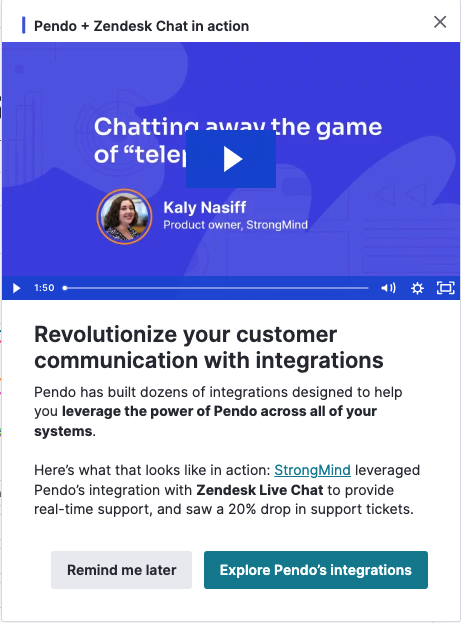
Product analytics data in Pendo can also help you personalize these communications and ensure you’re reaching the right users. For example, if you have two products that are complementary but sold separately, you can target users who have only purchased one of the products and explain why they’d benefit from using the second product as well.
Here are some other types of users you may want to target in cross-sell and upsell motions:
-
- Ideal customer profile (e.g. based on role, company size, or industry) for additional products
- Cohorts showing intent or engagement with other cross-sell channels
- Accounts that have a renewal coming up
- Customers who continually ask for more resources than what is provided by their customer success manager or your support team
2. Free trial and freemium conversion
If your company offers a free trial or freemium product, Pendo guides can help you streamline—and increase—conversions. Rather than requiring freemium and trial users to contact a sales representative to purchase, you can automate this workflow and let users start the upgrade process with a single click from inside the product.

Leverage product usage data to target in-app guides to users who are over their plan limit, or who show strong engagement throughout their free trial. For a freemium product, you can also create guides that appear when users click or hover over features that are only available in the premium product and include a CTA to initiate an upgrade right then and there.
Already a Pendo customer? Check out this recipe for using Pendo to increase your trial conversion rate.
3. Customer references and testimonials
Social proof is the ultimate form of marketing, but it’s not always easy to capture. In-app guides are a great way to collect references from users when they’re already engaged with your product, and when their opinions are top of mind. Capturing testimonials directly within your product also makes it easy for customers to share their thoughts since they don’t have to navigate away to another website or application.
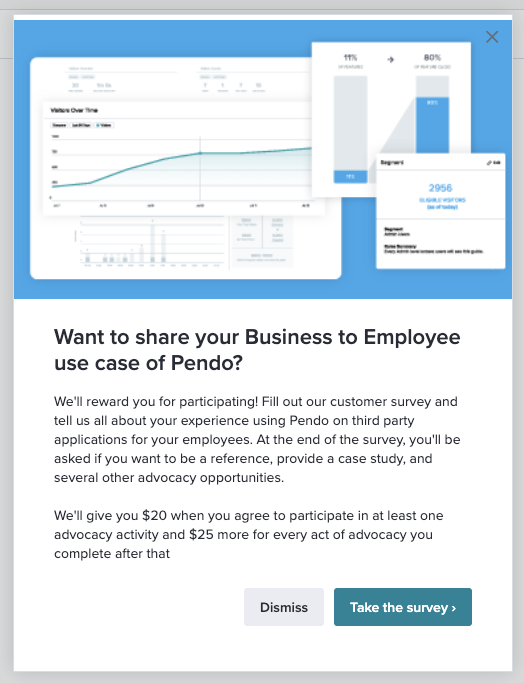
To ensure your outreach is effective, leverage product data in Pendo to identify who to target, like users who are highly engaged and access your product consistently. It’s also best practice to apply segments to your in-app messages, for example you might focus on customers using specific features, customers from enterprise companies, or specific personas or roles.
4. Launches
Marketers (and product marketers in particular) work with the product team to build robust, multi-channel launch campaigns for new products and features. While it’s important to reach customers in multiple places, the best place to market new functionality is in your actual product. Better yet: You can use Pendo data to personalize launch communications, making sure you’re exposing new features to users who will find the features most valuable.

Pendo’s in-app guides also make it easy to build in-app launch campaigns for releases of all sizes. For example, a large-scale release might include a lightbox announcement, a full in-app walkthrough, and a drip of additional in-app guides to remind users about the new functionality. A smaller release, on the other hand, might only require some contextual tooltips to point the new feature out to a subset of users.
5. Feature adoption
In addition to launch campaigns, marketers also work to drive long-term adoption—and can use Pendo guides to encourage users to continue engaging with key features long after they’re first released.
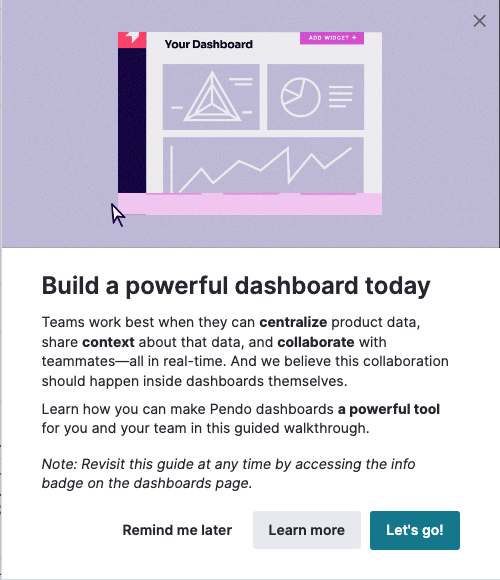
To start, look to your usage data in Pendo to identify where to focus your efforts. You might first target customer accounts or users with low overall adoption rates, or identify which high-value features are in most need of an adoption boost.
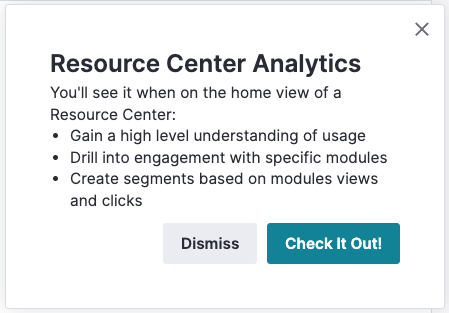
For features that are relatively straightforward, you might only need a simple tooltip that points out the feature and drives awareness. Some features, though, might warrant multi-step walkthroughs to help break down complex workflows and provide the proper level of detail. Also remember to always include a clear CTA in your guides—and ideally one that takes the user to the feature directly so they can start utilizing it immediately.
See Pendo in action: Take this self-guided tour to see how to use Pendo to analyze how customers engage with your product, identify opportunities to improve their experience, and guide them to your most valuable features.
6. Research
In the spirit of continuous iteration and improvement, marketers often partner with product and research teams to collect user input on initiatives that are still in progress—for example, renaming an existing product area, understanding the target audience for a new feature, or pricing and packaging updates.
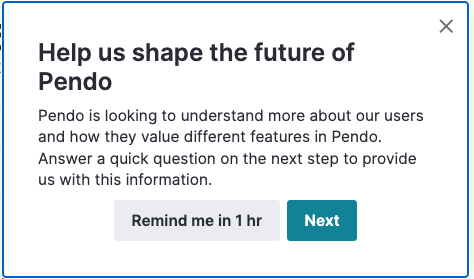
In addition to using product data in Pendo to better understand user behavior and the parts of your product customers use (and therefore value) the most, marketing teams can leverage in-app guides to capture the voice of the customer directly. Create in-app surveys and polls to collect persona data, or ask users what they think a new product or feature should be named.
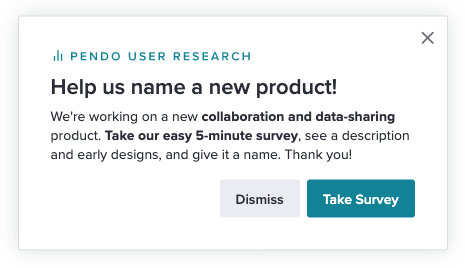
Bringing these communications in-app allows marketers to more easily test and validate ideas before anything goes to market. Teams can get feedback quickly and pass any relevant information over to the product team on a consistent basis. This data also informs marketing strategies once new products and features are released, allowing you to better connect new offerings to what users really value.
7. Event and content promotion
Your product is also an effective channel for promoting your latest content or any upcoming events. Thanks to product usage data and metadata in Pendo, you’ll be able to target these promotions to the exact audience who would find the event or content piece particularly valuable.
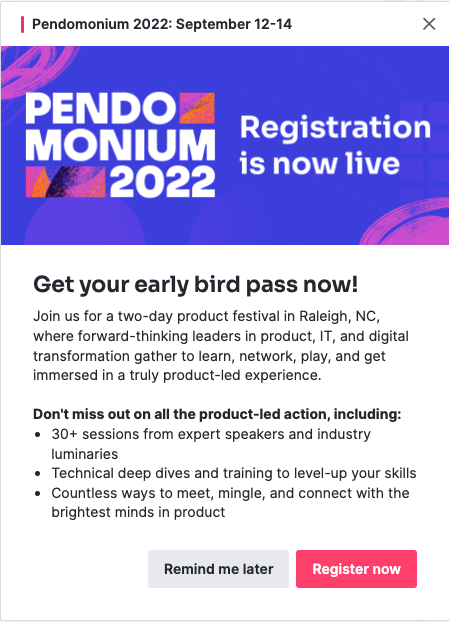
Here are some Pendo best practices for in-app event and content promotion:
-
- Be thoughtful about how guides are activated. If you’re hosting a webinar or recently released a white paper about a certain feature, set up guides to only trigger once users engage with that feature.
- Choose the right in-app guide format. Large-scale events that are relevant to the majority of your user base might call for an attention-grabbing lightbox, whereas educational webinars might be better promoted via a banner that doesn’t interfere with users’ workflows.
- Target guides to the right audience. If you’re promoting a user group in a certain city, use product analytics in Pendo to reach users in that geographic area. For content that’s relevant to a specific persona, ensure any in-app promotions are only shown to that cohort of users.
Want to dig deeper into how Pendo can help you operate more efficiently? Download “The inefficiency report” to learn 10 common areas of inefficiency and how you can overcome them with a product experience solution like Pendo.

